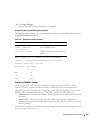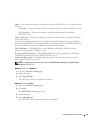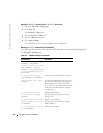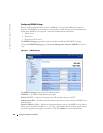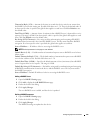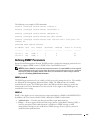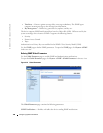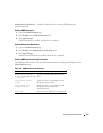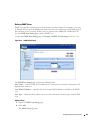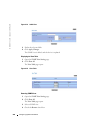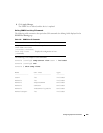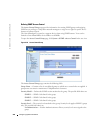
Configuring System Information 197
The following is an example of CLI commands:
Console (config)# radius-server timeout 5
Console (config)# radius-server retransmit 5
Console (config)# radius-server deadtime 10
Console (config)# radius-server key dell-server
Console (config)# radius-server host 196.210.100.1 auth-port 127
timeout 20
Console# show radius-servers
IP address Auth Acct TimeOut Retransmit Deadtime Source IP Priority
-------- ---- ---- ------ --------- ------- ------- ------
172.16.1.1 164 51646 3 3 0 01
172.16.1.2 164 51646 3 3 0 02
Defining SNMP Parameters
Simple Network Management Protocol (SNMP) provides a method for managing network devices.
The device supports SNMP version 1, SNMP version 2 and SNMP version 3.
NOTE: By default, SNMPv2 is automatically enabled on the device. To enable SNMPv3, a local engine ID
must be defined for the device. The local engine ID may be a string specified by the user or a generated
default string based on the MAC address of the device. For information on how to configure the local
engine ID, see Defining SNMP Global Parameters.
SNMP v1 and v2
The SNMP agent maintains a list of variables, which are used to manage the device. The variables
are defined in the Management Information Base (MIB). The MIB presents the variables
controlled by the agent. The SNMP agent defines the MIB specification format, as well as the
format used to access the information over the network. Access rights to the SNMP agent are
controlled by access strings.
SNMP v3
SNMP v3 also applies access control and a new traps mechanism to SNMPv1 and SNMPv2 PDUs.
In addition, the
User Security Model (USM) is defined for SNMPv3 and includes:
•
Authentication
— Provides data integrity and data origin authentication.
•
Privacy
— Protects against disclosure of message content. Cipher-Bock-Chaining
(CBC) is
used for encryption. Either authentication is enabled on a SNMP message, or both
authentication and privacy are enabled on a SNMP message. However privacy cannot be
enabled without authentication.



